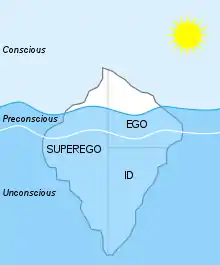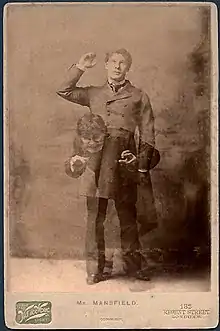Alter ego
An alter ego (Latin for "other I") means an alternative self, which is believed to be distinct from a person's normal or true original personality. Finding one's alter ego will require finding one's other self, one with a different personality. The altered states of the ego may themselves be referred to as alterations. A distinct meaning of alter ego is found in the literary analysis used when referring to fictional literature and other narrative forms, describing a key character in a story who is perceived to be intentionally representative of the author's work (or creator), by oblique similarities, in terms of psychology, behavior, speech, or thoughts, often used to convey the author's thoughts. The term is also sometimes, but less frequently, used to designate a hypothetical "twin" or "best friend" to a character in a story. Similarly, the term alter ego may be applied to the role or persona taken on by an actor[1] or by other types of performers.

Origin
Cicero coined the term as part of his philosophical construct in 1st-century Rome, but he described it as "a second self, a trusted friend".[2]
The existence of "another self" was first fully recognized in the 18th century, when Anton Mesmer and his followers used hypnosis to separate the alter ego.[3] These experiments showed a behavior pattern that was distinct from the personality of the individual when he was in the waking state compared with when he was under hypnosis. Another character had developed in the altered state of consciousness but in the same body.[4]
Freud throughout his career would appeal to such instances of dual consciousness to support his thesis of the unconscious.[5] He considered that “We may most aptly describe them as cases of a splitting of the mental activities into two groups, and say that the same consciousness turns to one or the other of these groups alternately”.[6] Freud considered the roots of the phenomenon of the alter ego to be in the narcissistic stage of early childhood.[7] Heinz Kohut would identify a specific need in that early phase for mirroring, by another which resulted later in what he called the “twinship or alter ego transference”.[8]

In popular culture and fiction

- The title characters in Robert Louis Stevenson's thriller Strange Case of Dr Jekyll and Mr Hyde represent an exploration of the concept that good and evil exist within one person, constantly at war.[9] Edward Hyde represents the doctor's other self, a psychopath who is unrestrained by the conventions of civilized society, and who shares a body with the doctor. The names "Jekyll and Hyde" have since become synonymous with a split personality or an alter ego that becomes capable of overpowering the original self.
- In the novel The Count of Monte Cristo by Alexandre Dumas, the main character Edmond Dantes after escaping from the Chateau d'If assumes the other three alter egos. The count of Monte Cristo, the Italian abbe called Giacomo Busoni, and the Englishman Lord Wilmore. In the novel, the Count of Monte Cristo rewards those who had been good to him while punishing those who contributed in one way or the other to his imprisonment. He leads M. Danglars to lose all his fortune, M. de Villefort to his madness, Fernand Mandego to commit suicide, and others more to their fate.
- In the 1999 Indian Malayalam Film Ustaad, Written by Ranjith and directed by Sibi Malayil, Mohanlal plays the character of Ustaad, which is an alter ego of the character Parameswaran.
- Norman Douglas in the late 1890s wrote a short story, "The Familiar Spirit", about a man who became aware while drowning of a conformist second self – "the presence within him of this Spirit, his alter ego, which is bent on crushing his ambition".[10]
- In comic books, superheroes and their secret identities are often considered the alter egos. The archetypal comic book hero, Superman, assumes the identity of the "mild-mannered" newspaper reporter Clark Kent to live among the citizens of Metropolis without arousing suspicion. The Incredible Hulk comic book series further complicates this theme, as Bruce Banner loses control to the Hyde-like Hulk whenever he becomes angry, yet also depends upon the Hulk's superpowers to combat villains. Comic book-inspired alter egos can be seen in other forms of popular fiction, including television and movie adaptations of comic books, parodies of this genre, and unrelated fiction.
- In the film and novel Fight Club, the narrator has an alter ego he loses control of, Tyler Durden.
- Sonic the Hedgehog and Shadow the Hedgehog are considered as alter ego look-a-likes of each other.
- In Disney's Hannah Montana, Miley Stewart, played by Miley Cyrus, leads the life of a high school student, and the life of teen pop sensation Hannah Montana allowing her to get the best of both worlds. Likewise, Miley's friends, Lilly Truscott, played by Emily Osment, and Oliver Oken, played by Mitchell Musso, also lead the lives of high school students and are what make up Hannah's entourage, Lola Luftnagle and Mike Stanley III respectively.
- In Pretty Little Liars is Vivian Darkbloom the alter ego of Alison Dilaurentis.
- Several famous musicians have adopted alter egos over the years, usually to indicate a new creative direction or a deep dive into their emotions removed from their popular stage persona—notable examples being David Bowie (with Ziggy Stardust and Aladdin Sane) and Prince (with Camille).[11] Particularly during the 2000s, several big-name singers dedicated album eras to reveal their alter egos, including Janet Jackson with Damita Jo, Mariah Carey with The Emancipation of Mimi, and Beyoncé with I Am ... Sasha Fierce.[12] Many rappers have also employed alter egos, notably Eminem, Lil' Kim, and Nicki Minaj, among others.
See also
References
- Glenn Daniel Wilson (1991). Psychology and Performing Arts. Taylor & Francis. ISBN 90-265-1119-1.
- "Alter Ego". Collins English Dictionary - Complete and Unabridged 10th Edition. William Collins Sons & Co. Ltd. 2009. Retrieved 13 January 2013.
- J Haule, Jung in the 21st Century II (2010) p. 88
- Pedersen, David (1994). Cameral Analysis: A Method of Treating the Psychoneuroses Using Hypnosis. London, U.K.: Routledge. p. 20. ISBN 0-415-10424-6.
- S Freud, Five Lectures on Psycho-Analysis (Penguin 1995) p. 21
- S Freud On Metapsychology (PFL 11) p. 172
- S Freud, 'The Uncanny' Imago V (1919) p. 41
- H Kohut, How Does Analysis Cure? (London 1984) p. 192-3
- I. Ousby ed., The Cambridge Guide to Literature in English (Cambridge 1995) p. 263
- N. Douglas, Looking Back (London 1934) p. 274
- Kotrial, Utsav (August 30, 2018). "The Origin Stories of Music's Biggest Alter Egos". Rolling Stone. Retrieved November 16, 2019.
- Juzwiak, Rich (June 18, 2019). "Madonna: Madame X Album Review". Pitchfork. Retrieved November 16, 2019.